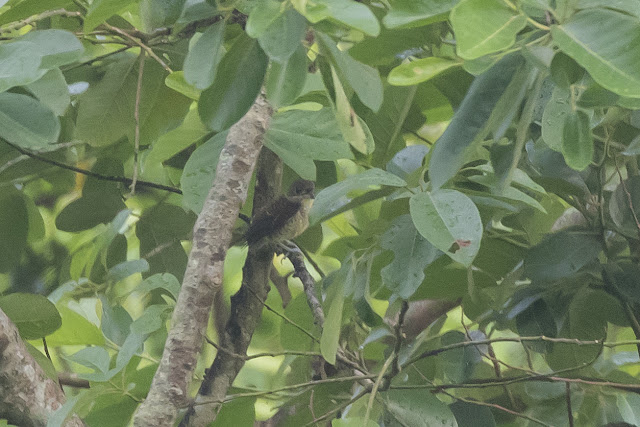
Brown Fish Owl - patrolling Cheung Chau Harbour
Arthroschista hilaralis - Hong Kong First!
The other nocturnal creature that I went looking for is a Brown Fish Owl that had been frequenting Chueng Chau harbour lately. This species is a resident at Cheung Chau, but is not always easy to observe due to their nocturnal nature. I was informed last week that one had been spotted again at the harbour and decided to try my luck along with David and Tom (My Dad joined late). Within ten minutes of our arrival to it's supposed location I spotted the large owl perched on top of a boat nearby, opposite a busy bustling harbour front of Cheung Chau. For the next two hours we enjoyed pretty decent views of this majestic owl feeding, as it actively dived down to catch fish attracted to the sewage outlet from the seafood restaurants. It's amazing to think that such an incredible creature can be living so close to humans without most of them ever noticing
Brown Fish Owl
Having successful night outings are always great. My daytime birding had been rather mediocre however, until one early morning I came upon a strange bird perched on the opposite side of the slope at Tai Po Kau, too far even for my binoculars to pick out the details, I took a photo with my camera and confirmed that it's a Tiger Shrike! A new species for my HK list of this rare migrant. It's a fairly compact Shrike species and heavily marked on both it's back and belly.
Tiger Shrike - my terrible attempt for a record shot...
Otherwise Tai Po Kau produced mainly common species, with plenty of Silver-eared Mesias, Streak-breasted Scimitar Babblers, Pygmy Wren Babblers and a few Hainan Blue Flycatchers. The increase in bird waves had made birding in Tai Po Kau a bit more pleasant and entertaining.
Silver-eared Mesia
Streak-breasted Scimitar Babbler
Pygmy Wren Babbler
Hainan Blue Flycatcher
Other small animals at Tai Po Kau are also rather active, I saw plenty of Brown Forest Skinks, one of which was basking on a rock and allowed me to get a good photo of these usually quick lizards. A close encounter with a cute Indochinese Forest Rat was also nice, this is also usually a nocturnal species, but every so often we get one that comes out during the day like this one. They prefer forested areas and rarely will venture into people's home, making them the "good" rats.
Brown Forest Skink
Indochinese Forest Rat
A quick visit to Long Valley this week yielded not much birds, highlight being a Brown Shrike at distance. Greater Painted Snipes are now quite active again and much more visible, I even saw a male trying to mount a female, although it looks to be an unsuccessful attempt...A single Numenius on a field caught my eye in the beginning, Little Curlew came to the top of my head, but a second glance confirms that it was indeed just a plain old Whimbrel. The Short-nosed Fruit Bats colony under a Chinese Fan-palm near Ho Sheung Heung is as always a good place to end a little trip to Long Valley and rarely disappoints.
Greater Painted Snipe - getting a bit frisky...
Whimbrel
Short-nosed Fruit Bat














Great to see the Brown Fish Owls, I'm inspired to seek them out closer to home...
ReplyDeleteThe Indochinese Forest Rat is very cute - don't think I've ever seen one.
Yes, I really think BFO are much more common then we think, but finding them is another matter...the rat is a baby one, apparently they grow much bigger then this.
Delete